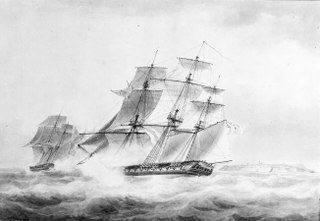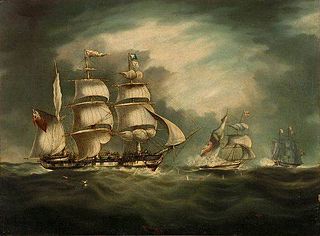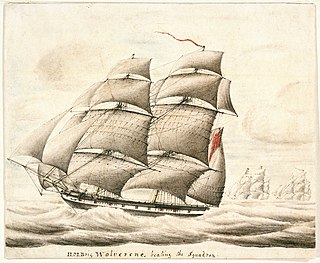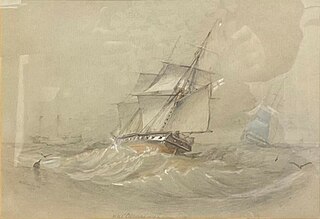
HMS Phoebe was a 36-gun fifth rate of the Royal Navy. She had a career of almost twenty years and fought in the French Revolutionary Wars, the Napoleonic Wars and the War of 1812. Overall, her crews were awarded six clasps to the Naval General Service Medals, with two taking place in the French Revolutionary Wars, three during the Napoleonic Wars and the sixth in the War of 1812. Three of the clasps carried the name Phoebe. During her career, Phoebe sailed to the Mediterranean and Baltic seas, the Indian Ocean, South East Asia, North and South America.

HMS Phoenix was a 36-gun Perseverance-class fifth-rate frigate of the Royal Navy. The shipbuilder George Parsons built her at Bursledon and launched her on 15 July 1783. She served in the French Revolutionary and Napoleonic Wars and was instrumental in the events leading up to the battle of Trafalgar. Phoenix was involved in several single-ship actions, the most notable occurring on 10 August 1805 when she captured the French frigate Didon, which was more heavily armed than her. She was wrecked, without loss of life, off Smyrna in 1816.

HMS Belle Poule was a Royal Navy fifth-rate frigate, formerly Belle Poule, a Virginie-class frigate of the French Navy that had been built by the Crucy family's shipyard at Basse-Indre to a design by Jacques-Noël Sané. She was launched on 17 April 1802, and saw active service in the East. In 1806 a British squadron under Sir John Borlase Warren captured her off La Palma in the Canary Islands. The Admiralty commissioned her into the Royal Navy as HMS Belle Poule. She was sold in 1816.

HMS Wolverine was a Royal Navy 18-gun Cruizer-class brig-sloop, launched in 1805 at Topsham, near Exeter. Early in her career she was involved in two fratricidal incidents, one involving a British frigate and then a newsworthy case in which she helped capture a British slave ship. She later captured a small naval vessel and several privateers, and took part in the invasion of Martinique, and during the War of 1812, in the attack on Baltimore. Wolverine was decommissioned in August or September 1815 and was sold on 15 February 1816.
HMS Anaconda was an 18-gun brig-sloop of the Royal Navy during the War of 1812. She was cruising as an American privateer until sailors from HMS Sceptre captured her in 1813. She served briefly in the Royal Navy during the later stages of the War of 1812, especially at the Battle of New Orleans, before being sold in Jamaica in 1815.
Fort Bowyer was a short-lived earthen and stockade fortification that the United States Army erected in 1813 on Mobile Point, near the mouth of Mobile Bay in what is now Baldwin County, Alabama, but then was part of the Mississippi Territory. The British twice attacked the fort during the War of 1812.
HMS Olympia was an Adonis-class schooner of the Royal Navy during the Napoleonic War. She was built at Bermuda using Bermudan cedar and completed in 1806. In March 1811 the French captured her, but the British recaptured her in October. During her career, she served as far afield as Buenos Aires, Île Bourbon, and Cape of Good Hope. The Admiralty sold her in 1815.

HMS Sophie was an 18-gun Cruizer class brig-sloop of the Royal Navy. She served during the Napoleonic Wars and the War of 1812. During the War of 1812 Sophie participated in the economic war against American trade, capturing or destroying numerous small merchant vessels, and in an unsuccessful attack on Fort Bowyer, Alabama. Later, she moved to the East Indies where she served in the First Anglo-Burmese War. The Admiralty sold Sophie in 1825.

HMS Persian was a Cruizer-class brig-sloop built by Daniel List and launched at Cowes in 1809. She captured two privateers before she wrecked in 1813.

HMS Cruizer was a Royal Navy Cruizer-class brig-sloop built by Stephen Teague of Ipswich and launched in 1797. She was the first ship of the class, but there was a gap of 5 years between her launch and the ordering of the next batch in October 1803; by 1815 a total of 105 other vessels had been ordered to her design. She had an eventful wartime career, mostly in the North Sea, English Channel and the Baltic, and captured some 15 privateers and warships, and many merchant vessels. She also participated in several actions. She was laid up in 1813 and the Commissioners of the Navy sold her for breaking in 1819.
During the French Revolutionary and Napoleonic Wars, British vessels captured at least 12 French warships and privateers named Espoir, which means “Hope” in French. In only one case was there mention of an exchange of fire or casualties. In general, the privateers tried to escape, and failing that surrendered.
HMS Barbara was an Adonis class schooner of the Royal Navy and launched in 1806. A French privateer captured her in 1807 and she became the French privateer Pératy. The Royal Navy recaptured her in 1808. She was paid off in June 1814 and sold in February 1815.

HMS Swallow was a Cruizer-class brig-sloop launched in December 1805, nine months late. She served the Royal Navy through the Napoleonic Wars, capturing numerous privateers. After the end of the wars she was broken up in 1815.

HMS Sealark was the American schooner Fly, launched in 1801 or 1811, that HMS Scylla captured in 1811. The Royal Navy took her into service as a 10-gun schooner. She participated in one notable single-ship action in 1812 that in 1847 the Admiralty recognized with a clasp to the Naval General Service Medal. She was sold in 1820.

HMS Childers was a brig-sloop of the British Royal Navy, initially armed with 10 carriage guns which were later increased to 14 guns. The first brig-sloop to be built for the Navy, she was ordered from a commercial builder during the early years of the American War of Independence, and went on to support operations in the English Channel and the Caribbean. Laid up for a time after the end of the American War of Independence, she returned to service shortly before the outbreak of the French Revolutionary Wars. She had an active career in both the French Revolutionary and Napoleonic Wars, capturing numerous French privateers and during the Gunboat War participated in a noteworthy single-ship action. The navy withdrew her from service at the beginning of 1811, at which time she was broken up.

HMS Orestes was a 16-gun brig-sloop of the Seagull class of the British Royal Navy, launched in October 1805. She served during the Napoleonic Wars, primarily in the North Sea and the Channel, where she captured three privateers. The Navy sold her in 1817.

HMS Childers was a Royal Navy 18-gun Cruizer-class brig-sloop that Nicholas Diddams built at Portsmouth Dockyard and launched in 1812. She was broken up in 1822.

HMS Royalist was launched in 1807. She captured many privateers and letters of marque, most French, but also some from Denmark and the United States. Her crew twice were awarded the Naval General Service Medal. She was instrumental in the capture of a French frigate. The Royal Navy sold her in 1819. She then became a whaler, making three complete voyages. She was condemned after a mishap while on her fourth.
HMS Growler was a Archer-class gun-brig built for the British Royal Navy and launched in 1804. She captured several French privateers and one Danish privateer, and took part in two actions that earned her crew the Naval General Service Medal (NGSM). She was sold in 1815.
HMS Attack was launched in 1804 as a later Archer-class gunbrig. Danish gunboats captured Attack in August 1812.














